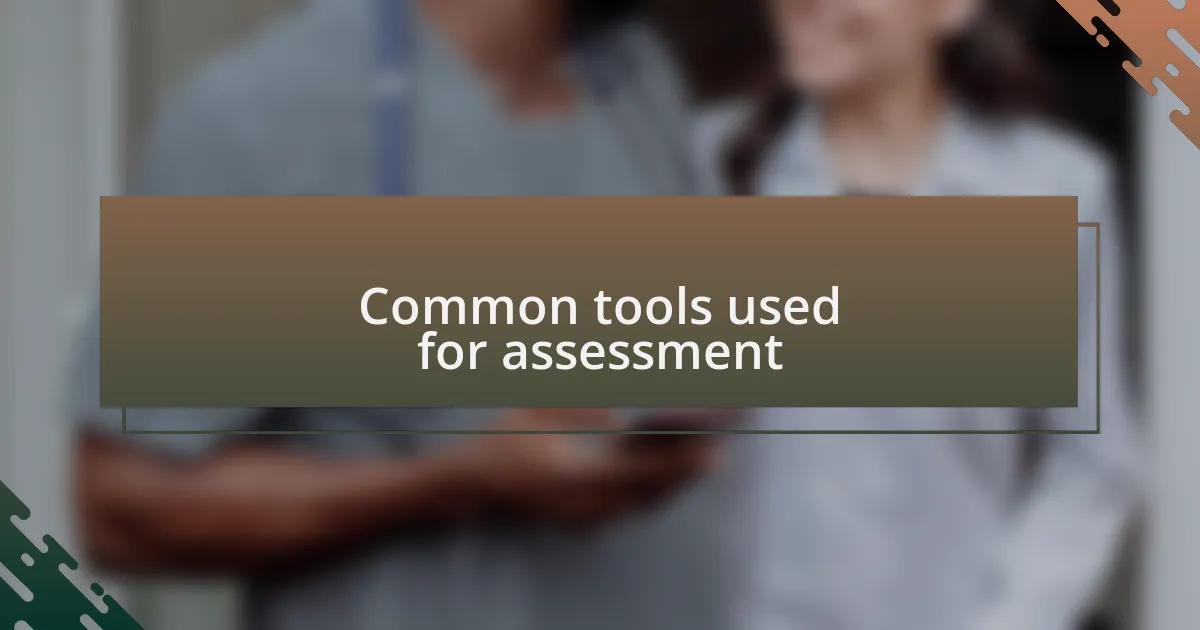Key takeaways:
- Tool reliability in medical decision support is essential for consistent and accurate patient care, with user experience playing a critical role in its effectiveness.
- The quality of underlying data and ongoing validation are crucial for maintaining tool reliability; outdated or biased data can lead to poor care decisions.
- Real-world user feedback is invaluable for assessing tool reliability, often revealing insights that quantitative data alone may miss.

Understanding tool reliability
Understanding tool reliability is crucial in medical decision support because it determines how consistently and accurately a tool performs its intended function. For instance, I once used a diagnostic tool that suggested different treatments based on patient data, and I vividly recall the nervousness I felt when the recommendations varied significantly depending on minor changes in input. It made me realize the importance of reliability; if a tool can’t maintain its accuracy over time, how can we trust it with our patients’ lives?
Moreover, evaluating a tool’s reliability often involves examining its performance across different patient populations. I remember attending a workshop where we discussed a tool designed for adult patients, but its efficacy in pediatric cases was questionable. This led me to wonder: How many tools are implemented without proper testing in diverse demographics? The answer is vital because, unfortunately, real-world applications may not reflect controlled study conditions.
Finally, one aspect that many may overlook is the user experience. I’ve had instances where complex interfaces led to misinterpretations of the tool’s output, which posed risks to patient care. So, I often ask myself, can a tool truly be considered reliable if it creates confusion? The usability of a tool is just as important as its statistical performance, blending reliability with practicality in everyday clinical settings.

Key factors influencing tool reliability
One of the primary factors influencing tool reliability is the quality of the underlying data. I once encountered a predictive analytics tool that relied on outdated patient information. This experience drove home the point that if the data isn’t accurate or representative, the tool’s output can lead to inappropriate care decisions. How can we trust a system built on shaky ground?
Additionally, the methodology employed in developing the tool matters significantly. I remember working with a diagnostic tool that relied on machine learning algorithms—a method that can be incredibly powerful but also introduces variability based on training data. When I learned about the sample population used during the development phase, it was clear that a lack of diversity could skew results. This made me wonder: Are we truly capturing the complexities of our patient population, or are we oversimplifying?
Lastly, ongoing validation and updates are crucial for maintaining reliability. I once consulted a clinical decision support system that hadn’t seen an update in years. I couldn’t shake the feeling that treating patients based on obsolete guidelines felt reckless. In my mind, it’s essential to ask: How frequently should these tools be reassessed to ensure they’re aligned with current medical standards? Only through continuous evaluation can we hope to provide the best care possible.

Steps to assess tool reliability
To assess tool reliability effectively, start by verifying the source of the data. I recall a time when I was evaluating an EHR-integrated decision aid, and the dataset it used came from a single institution. This raised a red flag for me—what about the broader population? It made me realize that a wider data set not only enhances reliability but also reflects a diverse patient experience.
Next, examine how the tool has been validated over time. I once worked with a clinical guideline tool that had undergone rigorous testing a few years ago but hadn’t been revisited since. This made me question: How can we truly trust something that’s no longer aligned with our rapidly changing medical landscape? It struck me that a tool without recent validation is like navigating without a map; no one wants to take that kind of risk when it comes to patient care.
Lastly, consider how user feedback is integrated into the evaluation process. I remember being in a meeting where healthcare professionals shared their experiences with a decision-making app. Their insights were invaluable; I realized that real-world use can highlight nuances no study or algorithm might capture. Could it be that the best assessments come not just from data, but from the voices of those actually using the tool? Engaging with end-users can uncover vital areas for improvement, making a difference in reliability.

Evaluating data sources for reliability
When evaluating data sources, the first step I take is to scrutinize the credibility of the authors behind the data. I vividly recall reviewing a clinical study that seemed promising at first, only to discover that the lead researchers had financial ties to a pharmaceutical company. This revelation made me think: how much trust can we place in findings influenced by potential biases? It’s crucial to consider not just the content, but also who is presenting it.
Another key aspect is the methodology used in the research. I once encountered a tool that cited extensive patient surveys as its evidence base, yet the survey sample was alarmingly skewed, primarily from a affluent community. This experience taught me that the context of data collection matters immensely; without a representative sample, the conclusions drawn can mislead practitioners. I often ask myself, are we willing to gamble on patient outcomes based on flawed information?
Moreover, I find it essential to investigate how peer-reviewed the data sources are. I remember being excited about a new diagnostic tool, only to discover that its supporting evidence was published in a non-peer-reviewed outlet. It struck me that the peer-review process acts as a gatekeeper, filtering out unreliable studies. I can’t help but wonder how many tools are used in practice based on shaky foundations, and if more scrutiny could lead to safer clinical decisions.

Common tools used for assessment
When assessing the reliability of tools in medical decision support, I often turn to statistical software and data analysis tools as a foundation. For example, I remember using a specific analytics platform that highlighted discrepancies in patient treatment outcomes. This hands-on experience underscored how powerful data visualization can guide clinical decisions, revealing patterns that would otherwise go unnoticed. Isn’t it fascinating how a well-designed graph can change the way we perceive complex information?
Another common tool is standardized assessment scales, like the Visual Analog Scale (VAS) for pain measurement. Once, during a workshop, I encountered clinicians who relied on this simple tool but hadn’t fully explored its limitations. I realized then that while standardized tools can offer valuable insights, they must be used in conjunction with a clinician’s expertise and judgment. How often do we overlook the nuances of patient experiences in favor of simplified metrics?
Finally, electronic health record (EHR) systems play a pivotal role in collating patient data for assessment. I’ve seen firsthand how integrated systems can provide comprehensive patient histories, but they can also lead to information overload if not designed thoughtfully. In my experience, the trick lies in balancing the depth of data with usability—how can we ensure that the tools we use enhance clinical decision-making without becoming a distraction?

Personal experiences in tool evaluation
Evaluating tools for medical decision support can feel overwhelming at times. I distinctly remember a project where I assessed a new diagnostic algorithm. It was easy to get lost in its technical specifications, but the real challenge was comparing its performance against existing tools. The moment I reviewed case studies demonstrating patient outcomes, it clicked for me—reliability isn’t just about accuracy; it’s about patient impact.
I also recall a conversation with a colleague who was skeptical about a new decision-support tool. We decided to pilot it in our practice. Observing how it both complemented and conflicted with our clinical intuition was eye-opening. It raised a thought: how often do we resist adopting new technologies simply because they disrupt our established routines?
Most recently, I experienced the value of user feedback in tool evaluation. In a training session with residents, they voiced concerns about an interface that seemed intuitive to the developers but not to the users. Their insights were invaluable; it reminded me that tools must be assessed not only for functionality but also for user experience. Were we truly making things easier, or were we creating hurdles?